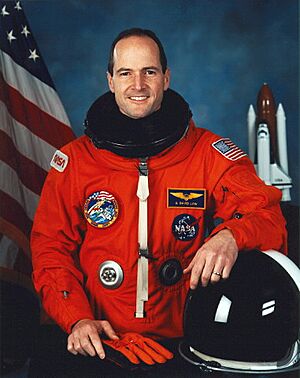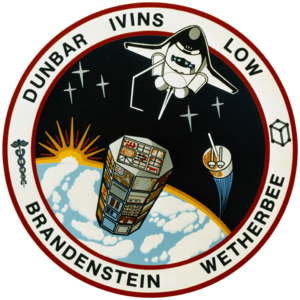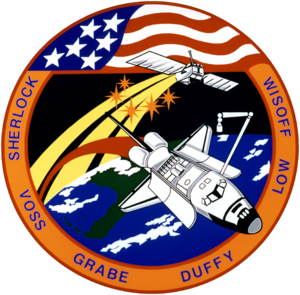G. David Low facts for kids
Quick facts for kids
David Low
|
|
|---|---|
 |
|
| Born |
George David Low
February 19, 1956 |
| Died | March 15, 2008 (aged 52) Reston, Virginia, U.S.
|
| Space career | |
| NASA astronaut | |
|
Time in space
|
29d 18h 5m |
| Selection | NASA Group 10 (1984) |
| Missions | STS-32 STS-43 STS-57 |
|
Mission insignia
|
  |
| Retirement | 1996 |
George David Low (born February 19, 1956 – died March 15, 2008) was an amazing American astronaut. He also became a leader in companies that build spacecraft. David had degrees in physics, mechanical engineering, and aeronautics. Before becoming an astronaut, he worked at the Jet Propulsion Laboratory (JPL) in California. NASA chose him to be an astronaut in 1984. He spent over 714 hours in space, flying on Space Shuttles like Columbia, Atlantis, and Endeavour. After leaving NASA in 1996, he worked in the private space industry. His father, George M. Low, was also famous in space history. He managed the Apollo Spacecraft Program.
Contents
About David Low
David Low was born in Cleveland, Ohio, on February 19, 1956. His parents were George and Mary Ruth Low. As a kid, he was active in the Boy Scouts of America. He even reached a high rank called Life Scout. David married JoAnn Andochick, and they had three children together. He loved playing tennis, lacrosse, scuba diving, and running. He also enjoyed spending time with his family. A cool fact: his father suggested that the Apollo 8 mission should fly to the Moon in 1968! Sadly, David Low passed away from cancer on March 15, 2008. He died at Reston Hospital Center in Virginia.
David's Education
David Low was a very smart student. He graduated from Langley High School in Virginia in 1974. He earned a Bachelor of Science degree in Physics and Engineering from Washington & Lee University in 1978. Then, he got another Bachelor of Science degree in mechanical engineering from Cornell University in 1980. He continued his studies and received a Master of Science degree in aeronautics and astronautics from Stanford University in 1983. He also attended Harvard University and Johns Hopkins University.
Groups David Low Joined
David Low was part of several important groups. These groups are for people who work in science and engineering.
- He was an Associate Fellow of the American Institute of Aeronautics and Astronautics. This is a big group for space and aviation experts.
- He was also a member of Omicron Delta Kappa. This is a leadership honor society.
- He was a member of Phi Kappa Sigma.
Awards and Special Honors
David Low received many awards for his work. These show how important his contributions were.
- He earned three NASA Space Flight Medals. These are given for flying in space.
- He also received the NASA Exceptional Service Medal.
- He got the NASA Outstanding Leadership Medal.
- He received an honorary engineering degree from Rensselaer Polytechnic Institute.
- A special spacecraft was named after him! The first Cygnus Orb-D1 cargo spacecraft was called the S.S. G. David Low. This was done to honor his memory. All future Cygnus spacecraft are named after people involved in space.
David's Space Career
Before becoming an astronaut, David Low worked at the Jet Propulsion Laboratory (JPL). This was from 1980 to 1984. At JPL, he helped plan future missions to other planets. He also worked on the design of the Galileo spacecraft. This spacecraft later explored Jupiter. He was also the main engineer for the Mars Observer mission.
Becoming a NASA Astronaut
NASA chose David Low as an astronaut candidate in May 1984. He officially became an astronaut in June 1985. He had many important jobs on Earth before flying to space.
- He worked on the Canadarm (a robotic arm used on the Space Shuttle).
- He helped with Extra-vehicular activity (EVA), which means spacewalks.
- He checked out the Space Shuttle at the Kennedy Space Center.
- He was a CAPCOM in the Mission Control Center. This meant he was the main person talking to astronauts in space during missions.
- He helped design the new International Space Station.
- He managed the office for spacewalks.
- He worked with the United States Congress to share information about NASA's programs.
David Low flew on three space missions. He spent over 714 hours in space. This included almost six hours on a spacewalk! He was a mission specialist on STS-32 and STS-43. He was also the payload commander on STS-57. In February 1996, David Low left NASA. He then joined a company called Orbital Sciences Corporation. There, he continued his work in the aerospace industry.
David's Spaceflights
STS-32: His First Mission
David Low's first space mission was STS-32. It launched from the Kennedy Space Center in Florida on January 9, 1990. He flew on the Space Shuttle Columbia. The crew successfully launched a communications satellite called Syncom IV-F5. They also used the Canadarm to bring back a large experiment called the Long Duration Exposure Facility (LDEF). The astronauts also did many science experiments and used an IMAX camera. After orbiting Earth 173 times, Columbia landed in California on January 20, 1990.
STS-43: Flying on Atlantis
David Low's next mission was STS-43. He was the flight engineer on the Space Shuttle Atlantis. This nine-day mission launched from Florida on August 2, 1991. The crew launched a satellite called TDRS-E. This satellite helps communicate with other spacecraft. They also did 32 different science experiments. These experiments helped prepare for the Space Station Freedom (which later became the International Space Station). After orbiting Earth 142 times, Atlantis landed back in Florida on August 11, 1991.
STS-57: Spacewalk and New Experiments
On his third mission, STS-57, David Low was the payload commander. He flew on the Space Shuttle Endeavour. This mission launched from Florida on June 21, 1993. The main goal was to bring back the European Retrievable Carrier (EURECA) satellite. They used the Canadarm for this. This mission also had the first flight of Spacehab. Spacehab was a special module that added more space for experiments. It carried 22 different science experiments.
During this mission, David Low did a spacewalk with astronaut Peter J.K. Wisoff. Their spacewalk lasted almost six hours! They moved antennas on the EURECA satellite. They also tested new tools and methods for future spacewalks. Endeavour landed back in Florida on July 1, 1993. This mission completed 155 orbits of Earth.
Images for kids





